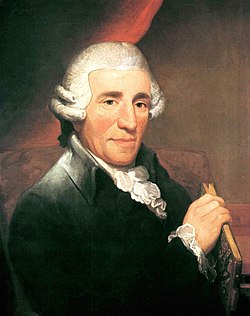Movements
The work is in standard four movement form and scored for two flutes, two oboes, two bassoons, two horns, two trumpets, timpani and strings.
- Adagio, 3
4 – Allegro, 3
4 - Andante, 6
8 in G major - Menuetto: Allegretto, 3
4 - Finale: Vivace, 2
4
The first movement is in sonata form. Following a slow introduction, the first theme of the exposition is actually two overlapping themes, a short–short–short–long repeated-note theme in the first violins over a falling motif in the middle strings and bassoons. Following a brief transitional section, the first theme returns giving the opening section a ternary structure. [1] The first theme group closes with fanfares featuring repeated notes. What follows is a more extended transition featuring three repeated eighth-notes as in the opening of the Allegro. There is no true second theme group making this a three-key exposition. [1] The expositional coda also features motifs containing three eighth notes. The development can be divided into three sections. [1] The first section develops the exposition's first theme and the second develops themes from the exposition's coda. Both of these sections touch on the relative minor, B minor. Following a two-measure grand pause, the third section opens with a false recapitulation of the exposition in the wrong key of G major which quickly collapses into more development of the first theme. When the recapitulation arrives, it proceeds quickly. Following another transition, the fanfares from the first theme group return building up to an unexpected stormy climax in D minor leaving just seven measures of D major to bring the movement to a close. [1]
The slow movement in G major is in ternary form (A–B–A) [1] featuring a lightly scored, lilting theme with three upbeats. [3] The central "B" section of the movement is for full tutti in G minor and is highly contrapuntal. [1] The second "A" section finishes suspended on a cadential six-four chord. The following coda is indeed an orchestral cadenza featuring solos from the two principal violinists (including Salomon) and solos from the principal winds as well. [3]
The trio of the minuet features an extended oboe solo. [1]
The finale is a five-part rondo form (A–B–A–C–A), although it does include some elements of sonata form, implying that it could be a hybrid of both forms. The principal A section is primarily for the strings but are joined by the woodwinds in other areas. The B section revolves around D minor, while the C section features a short modulation to A major, thus showing a similarity to sonata form as mentioned above. Rhythmic patterns from both sections are referenced in the movement's coda.
This page is based on this
Wikipedia article Text is available under the
CC BY-SA 4.0 license; additional terms may apply.
Images, videos and audio are available under their respective licenses.

